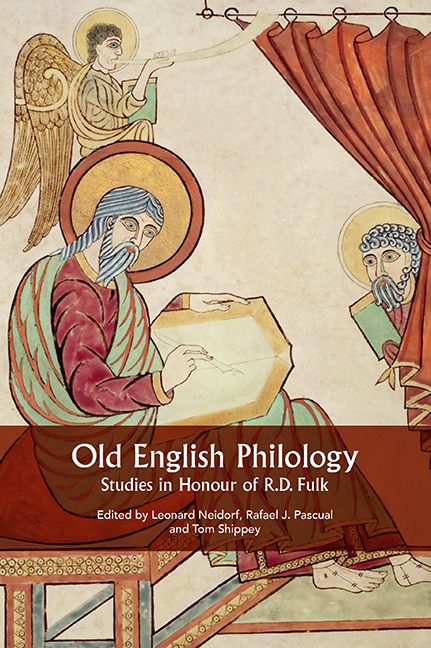Book contents
- Frontmatter
- Contents
- List of Illustrations
- Acknowledgements
- List of Contributors
- Introduction: R.D. Fulk and the Progress of Philology
- 1 Sievers, Bliss, Fulk, and Old English Metrical Theory
- 2 Ictus as Stress or Length: The Effect of Tempo
- 3 Metrical Criteria for the Emendation of Old English Poetic Texts
- 4 The Suppression of the Subjunctive in Beowulf: A Metrical Explanation
- 5 Metrical Complexity and Verse Placement in Beowulf
- 6 Alliterating Finite Verbs and the Origin of Rank in Old English Poetry
- 7 Prosody-Meter Correspondences in Late Old English and Poema Morale
- 8 The Syntax of Old English Poetry and the Dating of Beowulf
- 9 The Anglo-Saxons and Superbia: Finding a Word for it
- 10 Old English gelōme, gelōma, Modern English loom, lame, and Their Kin
- 11 Worm: A Lexical Approach to the Beowulf Manuscript
- 12 Wulfstan, Episcopal Authority, and the Handbook for the Use of a Confessor
- 13 Some Observations on e-caudata in Old English Texts
- 14 The Poetics of Poetic Words in Old English
- 15 Dream of the Rood 9b: A Cross as an Angel?
- 16 The Fate of Lot’s Wife: A ‘Canterbury School’ Gloss in Genesis A
- 17 Metrical Alternation in The Fortunes of Men
- 18 The Originality of Andreas
- 19 The Economy of Beowulf
- 20 Beowulf Studies from Tolkien to Fulk
- The Writings of R.D. Fulk
- Index
- Tabula Gratulatoria
- Anglo-Saxon Studies
14 - The Poetics of Poetic Words in Old English
Published online by Cambridge University Press: 29 May 2021
- Frontmatter
- Contents
- List of Illustrations
- Acknowledgements
- List of Contributors
- Introduction: R.D. Fulk and the Progress of Philology
- 1 Sievers, Bliss, Fulk, and Old English Metrical Theory
- 2 Ictus as Stress or Length: The Effect of Tempo
- 3 Metrical Criteria for the Emendation of Old English Poetic Texts
- 4 The Suppression of the Subjunctive in Beowulf: A Metrical Explanation
- 5 Metrical Complexity and Verse Placement in Beowulf
- 6 Alliterating Finite Verbs and the Origin of Rank in Old English Poetry
- 7 Prosody-Meter Correspondences in Late Old English and Poema Morale
- 8 The Syntax of Old English Poetry and the Dating of Beowulf
- 9 The Anglo-Saxons and Superbia: Finding a Word for it
- 10 Old English gelōme, gelōma, Modern English loom, lame, and Their Kin
- 11 Worm: A Lexical Approach to the Beowulf Manuscript
- 12 Wulfstan, Episcopal Authority, and the Handbook for the Use of a Confessor
- 13 Some Observations on e-caudata in Old English Texts
- 14 The Poetics of Poetic Words in Old English
- 15 Dream of the Rood 9b: A Cross as an Angel?
- 16 The Fate of Lot’s Wife: A ‘Canterbury School’ Gloss in Genesis A
- 17 Metrical Alternation in The Fortunes of Men
- 18 The Originality of Andreas
- 19 The Economy of Beowulf
- 20 Beowulf Studies from Tolkien to Fulk
- The Writings of R.D. Fulk
- Index
- Tabula Gratulatoria
- Anglo-Saxon Studies
Summary
It is difficult to reach an appropriate estimate of the aesthetic value of the Old English poetic vocabulary. There is an abundance of research that we can do, and have done, with this body of words: we can catalogue them, establishing along the way the criteria that determine their classification (Griffith 1991); we can compare the alliterative frequencies of poetic and non-poetic words (Cronan 1986; Griffith 2013); we can examine the occurrences of those poetic words which also appear in prose and glosses (Frank 1994; Griffith 2014); we can identify and discuss the poetic meanings of polysemantic words (Cronan 2003); we can analyze the usage and/or distribution of these words in individual poems (Metcalf 1973; Griffith 1991); and we can investigate the evidence that words with limited distribution provide for dating (Cronan 2004; Neidorf 2013–14). As necessary and important as this research is, it remains a means to an end – the achievement of a fuller understanding of the nature and the value of the poetic character of the vocabulary as a whole. Unfortunately this goal has proved to be rather elusive for modern scholars whose own direct poetic experience is based upon a tradition which dates back only to Chaucer. This later tradition developed around the reliable constants of end-rhyme, predictable, if frequently varied, metrical patterns, and a diction that often relied, to a greater or lesser degree, upon words also used in colloquial English or in educated discourse. One constant in the verse of the last six hundred years is that the poetic quality of individual words usually depends upon their selection and placement in the poetic line and passage. When we turn from this verse, in which aesthetic value is a product of the usage and combination of individual words, to the phenomenon of the overwhelming mass of poetic words in Old English, we cannot help but wonder if these words as a group are poetic in any sense apart from their restriction to verse. Some scholars are inclined to dismiss these words as a technical resource for meeting the demands of alliteration and the verse-structure, while others pursue the opposite course and attempt to distinguish the meanings and connotations of individual words and to approach their usage in ways that differ little from analyses of more recent poetry.
- Type
- Chapter
- Information
- Old English PhilologyStudies in Honour of R.D. Fulk, pp. 256 - 275Publisher: Boydell & BrewerPrint publication year: 2016

